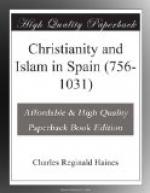[1] Sale, Introduction to Koran, p. 91.
[2] Alvar, “Ind. Lum.,” sec. 25.
[3] Ibid., sec. 21.
[4] Ibid., sec. 53.
[5] See Koran, v. ad fin.:—“And when God shall say unto Jesus at the last day: O Jesus, son of Mary, hast thou said unto men, Take me and my mother for two Gods, beside God? he shall answer, Praise be unto thee! it is not for me to say that which I ought not.”
[6] P. 56.
But the following extract from a treatise on Religions, by Ali ibn Hazm,[1] the prime minister of Abdurrahman V. (Dec. 1023-March 1024), will show that some educated Moslems knew enough of the Christian creed to appreciate its difficulties:—“We need not be astonished,” says Ibn Hazm, “at the superstition of men. Look at the Christians! They are so numerous that God only knows their numbers. They have among them men of great intelligence, and princes of great ability. Nevertheless they believe that three is one, and one is three; that one of the three is the Father, another the Son, another the Spirit; that the Father is, and is not, the Son; that a man is, and is not, God; that the Messiah is God in every respect, and yet not the same as God; that He who has existed from all eternity has been created.
“One of their sects, the members of which they call Jacobites, and which number hundreds of thousands, believes even that the Creator Himself was scourged, crucified, and put to death; so that the Universe for three days was deprived of its Governor.”
Another extract from an Arabic writer will show us what the Moslems thought of the worship of St James, the patron saint of Spain, round whose shrine rallied the religious revival in the north of the Peninsula. It is Ibn Hayyan,[2] who, in his account of Almanzor’s fiftieth expedition against the Christians, says:—“Shant Yakoh (Santiago)[3] is one of the sanctuaries most frequented, not only by the Christians of Andalus, but of the neighbouring continent, who look upon its church with a veneration such as Moslems entertain for the Caaba of Mecca; for their Caaba is a colossal idol (statue) which stands in the middle of the church. They swear by it, and repair to it in pilgrimage from the most distant parts, from Rome, as well as other countries beyond Rome, pretending that the tomb to be seen in the church is that of Yakob (James), one of the twelve apostles, and the most beloved by Isa (Jesus).—May the blessing of God be on him, and on our Prophet!—The Christians call this Yakob the brother of Jesus, because, while he lived, he was always with him. They say that he was Bishop of Jerusalem, and that he wandered over the earth preaching the religion [of Christ], and calling upon the inhabitants to embrace it, till he came to that remote corner of Andalus; that he then returned to Syria, where he died at the age of 120 solar years. They pretend likewise that, after the death of Yakob, his disciples carried his body and buried it in that church, as the most remote part, where he had left traces [of his preaching].”




